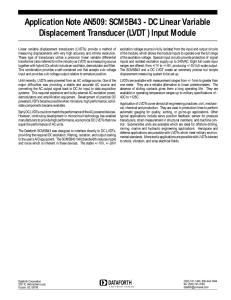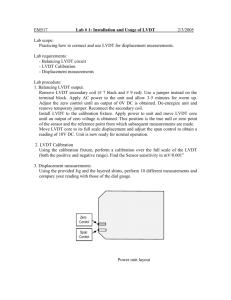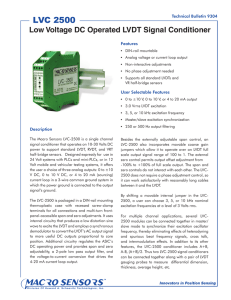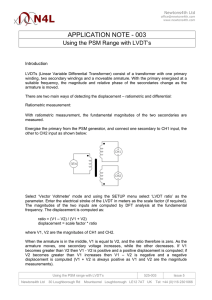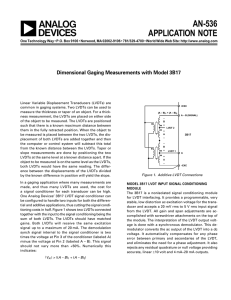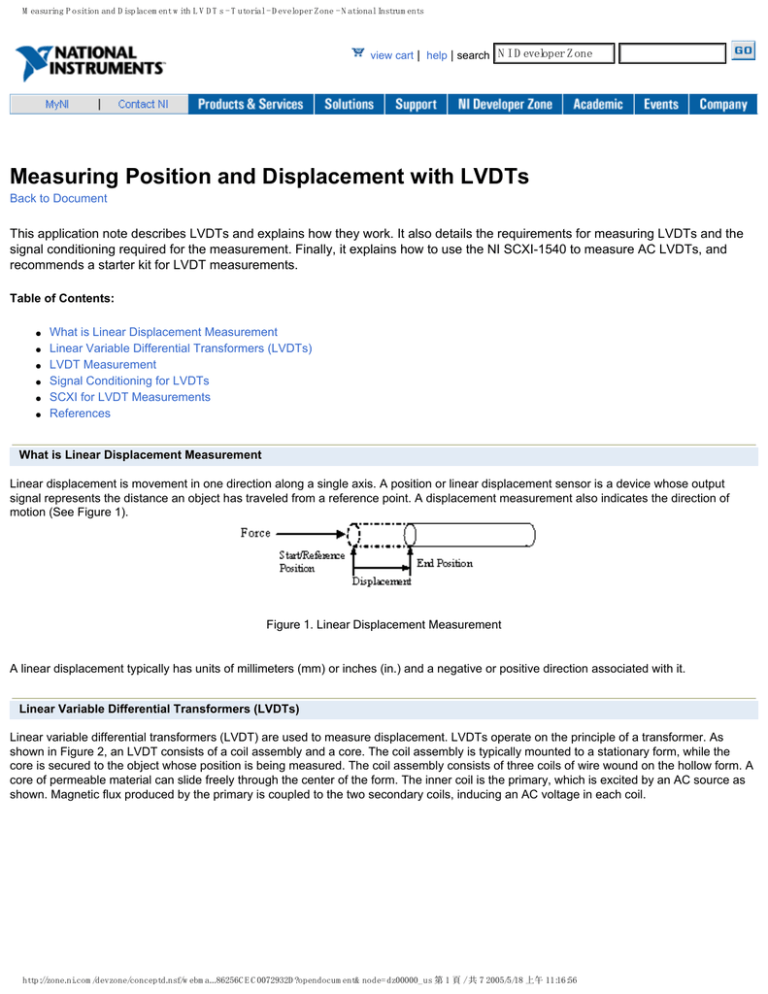
Measuring Position and Displacement with LVDTs - Tutorial - Developer Zone - National Instruments
view cart | help | search NI Developer Zone
Measuring Position and Displacement with LVDTs
Back to Document
This application note describes LVDTs and explains how they work. It also details the requirements for measuring LVDTs and the
signal conditioning required for the measurement. Finally, it explains how to use the NI SCXI-1540 to measure AC LVDTs, and
recommends a starter kit for LVDT measurements.
Table of Contents:
●
●
●
●
●
●
What is Linear Displacement Measurement
Linear Variable Differential Transformers (LVDTs)
LVDT Measurement
Signal Conditioning for LVDTs
SCXI for LVDT Measurements
References
What is Linear Displacement Measurement
Linear displacement is movement in one direction along a single axis. A position or linear displacement sensor is a device whose output
signal represents the distance an object has traveled from a reference point. A displacement measurement also indicates the direction of
motion (See Figure 1).
Figure 1. Linear Displacement Measurement
A linear displacement typically has units of millimeters (mm) or inches (in.) and a negative or positive direction associated with it.
Linear Variable Differential Transformers (LVDTs)
Linear variable differential transformers (LVDT) are used to measure displacement. LVDTs operate on the principle of a transformer. As
shown in Figure 2, an LVDT consists of a coil assembly and a core. The coil assembly is typically mounted to a stationary form, while the
core is secured to the object whose position is being measured. The coil assembly consists of three coils of wire wound on the hollow form. A
core of permeable material can slide freely through the center of the form. The inner coil is the primary, which is excited by an AC source as
shown. Magnetic flux produced by the primary is coupled to the two secondary coils, inducing an AC voltage in each coil.
http://zone.ni.com/devzone/conceptd.nsf/webma...86256CEC0072932D?opendocument&node=dz00000_us 第 1 頁 / 共 7 2005/5/18 上午 11:16:56
Measuring Position and Displacement with LVDTs - Tutorial - Developer Zone - National Instruments
Figure 2. General LVDT Assembly
The main advantage of the LVDT transducer over other types of displacement transducer is the high degree of robustness. Because there is
no physical contact across the sensing element, there is no wear in the sensing element.
Because the device relies on the coupling of magnetic flux, an LVDT can have infinite resolution. Therefore the smallest fraction of
movement can be detected by suitable signal conditioning hardware, and the resolution of the transducer is solely determined by the
resolution of the data acquisition system.
LVDT Measurement
An LVDT measures displacement by associating a specific signal value for any given position of the core. This association of a signal value
to a position occurs through electromagnetic coupling of an AC excitation signal on the primary winding to the core and back to the
secondary windings. The position of the core determines how tightly the signal of the primary coil is coupled to each of the secondary coils.
The two secondary coils are series-opposed, which means wound in series but in opposite directions. This results in the two signals on each
secondary being 180 deg out of phase. Therefore phase of the output signal determines direction and its amplitude, distance.
Figure 3 depicts a cross-sectional view of an LVDT. The core causes the magnetic field generated by the primary winding to be coupled to
the secondaries. When the core is centered perfectly between both secondaries and the primary, as shown, the voltage induced in each
secondary is equal in amplitude and 180 deg out of phase. Thus the LVDT output (for the series-opposed connection shown in this case) is
zero because the voltages cancel each other.
http://zone.ni.com/devzone/conceptd.nsf/webma...86256CEC0072932D?opendocument&node=dz00000_us 第 2 頁 / 共 7 2005/5/18 上午 11:16:56
Measuring Position and Displacement with LVDTs - Tutorial - Developer Zone - National Instruments
Figure 3. Cross-Sectional View of LVDT Core and Windings
Displacing the core to the left (Figure 4) causes the first secondary to be more strongly coupled to the primary than the second secondary.
The resulting higher voltage of the first secondary in relation to the second secondary causes an output voltage that is in phase with the
primary voltage.
Figure 4. Coupling to First Secondary Caused by Associated Core Displacement
Likewise, displacing the core to the right causes the second secondary to be more strongly coupled to the primary than the first secondary.
The greater voltage of the second secondary causes an output voltage to be out of phase with the primary voltage.
Figure 5. Coupling to Second Secondary Caused by Associated Core Displacement
To summarize, “The LVDT closely models an ideal zeroth-order displacement sensor structure at low frequency, where the output is a direct
and linear function of the input. It is a variable-reluctance device, where a primary center coil establishes a magnetic flux that is coupled
through a center core (mobile armature) to a symmetrically wound secondary coil on either side of the primary. Thus, by measurement of the
voltage amplitude and phase, one can determine the extent of the core motion and the direction, that is, the displacement.”[1] Figure 6 shows
the linearity of the device within a range of core displacement. Note that the output is not linear as the core travels near the boundaries of its
range. This is because less magnetic flux is coupled to the core from the primary. However, because LVDTs have excellent repeatability,
http://zone.ni.com/devzone/conceptd.nsf/webma...86256CEC0072932D?opendocument&node=dz00000_us 第 3 頁 / 共 7 2005/5/18 上午 11:16:56
Measuring Position and Displacement with LVDTs - Tutorial - Developer Zone - National Instruments
nonlinearity near the boundaries of the range of the device can be predicted by a table or polynomial curve-fitting function, thus extending the
range of the device.
Figure 6: Proportionally Linear LVDT Response to Core Displacement
Signal Conditioning for LVDTs
Because the output of an LVDT is an AC waveform, it has no polarity. The magnitude of the output of an LVDT increases regardless of the
direction of movement from the electrical zero position.
In order to know in which half of the device the center of the core is located, one must consider the phase of the output as well as the
magnitude as compared to the AC excitation source on the primary winding. The output phase is compared with the excitation phase and it
can be either in or out of phase with the excitation source, depending upon which half of the coil the center of the core is in.
The signal conditioning electronics must combine information on the phase of the output with information on the magnitude of the output, so
the user can know the direction the core has moved as well as how far from the electrical zero position it has moved.
LVDT signal conditioners generate a sinusoidal signal as an excitation source for the primary coil. “This signal is typically between 50 Hz and
25 kHz. The carrier frequency is generally selected to be at least 10 times greater than the highest expected frequency of the core motion.”[1]
The signal conditioning circuitry synchronously demodulates the secondary output signal with the same primary excitation source. The
resulting DC voltage is proportional to core displacement. The polarity of the DC voltage indicates whether the displacement is toward or
away from the first secondary (displacement left or right).
Figure 7 shows a practical detection scheme, typically provided as a single integrated circuit (IC) manufactured specifically for LVDTs. The
system contains a signal generator for the primary, a phase-sensitive detector (PSD) and amplifier/filter circuitry.
Figure 7. Sophisticated Phase-Sensitive LVDT Signal Conditioning Circuit
Broad ranges of LVDTs are available with linear ranges from at least ±50 cm down to ±1 mm. The time response is dependent on the
equipment to which the core is connected. The units of an LVDT measurement are typically in mV/V/mm or mV/V/in. This indicates that for
every volt of stimulation applied to the LVDT there is a definite feedback in mV per unit distance. A carefully manufactured LVDT can provide
an output linear within ±0.25% over a range of core motion, with very fine resolution. The resolution is limited primarily by the ability of signal
conditioning hardware to measure voltage changes.
SCXI for LVDT Measurements
SCXI is a signal conditioning platform for PC-based data acquisition (DAQ) systems used in instrumentation applications. An SCXI system
http://zone.ni.com/devzone/conceptd.nsf/webma...86256CEC0072932D?opendocument&node=dz00000_us 第 4 頁 / 共 7 2005/5/18 上午 11:16:56
Measuring Position and Displacement with LVDTs - Tutorial - Developer Zone - National Instruments
consists of a shielded chassis that houses a combination of signal conditioning input and output modules, which perform a variety of signal
conditioning functions. You can connect many different types of transducers, including LVDTs, directly to SCXI modules. SCXI operates as a
front-end signal conditioning system for PC plug-in DAQ devices (such as PCI or PCMCIA) or DAQ modules in PXI measurement and
automation systems.
Figure 8. SCXI Signal Conditioning System
The National Instruments SCXI-1540 8-channel LVDT module provides the necessary conditioning to measure signals from transformerbased ratiometric position sensors, including LVDTs, rotary variable differential transformers (RVDTs), and resolvers. The SCXI-1540 offers
both 4 and 5-wire connections for LVDTs and RVDTs. In addition, this module offers autocalibration without external hardware using NI-DAQ
driver software. Each of these modules can multiplex its signals into a single channel of the DAQ device, and modules can be added to
increase channel count. With random scanning capabilities, you can select only the channels from which you want to acquire data.
How to Connect LVDTs
LVDTs typically come in 4-wire (open wire) and 5-wire (ratiometric wire) configurations. Wires from the sensor connect to a signal
conditioning circuit that translates the output of the LVDT to a measurable voltage. The two circuits in the figures below depict the external
connections to the conditioning circuit.
Figure 9. 4-Wire Connection of an LVDT to a Signal Conditioning Circuit
http://zone.ni.com/devzone/conceptd.nsf/webma...86256CEC0072932D?opendocument&node=dz00000_us 第 5 頁 / 共 7 2005/5/18 上午 11:16:56
Measuring Position and Displacement with LVDTs - Tutorial - Developer Zone - National Instruments
Figure 10. 5-Wire Connection of an LVDT to a Signal Conditioning Circuit
Note: The color of the wires may vary.
4-wire and 5-wire configurations are differentiated by the way the signals from the first and second secondaries are conditioned. In the 4-wire
configuration, only the voltage difference between the two secondaries is measured. The following equation relates the measured voltage to
the displacement, where G is the gain or sensitivity:
(Equation 1)
The benefit of using a 4-wire configuration is that you require a simpler signal conditioning system. “This is at the expense of temperature
stability and phase coherence between the primary excitation voltage and the resulting secondary voltages. Temperature changes can alter
the LVDT’s magnetic induction efficiency. This causes a change in the perceived voltage for a given displacement. Because the 4-wire
scheme is also sensitive to phase changes between the primary and the resulting secondary voltage, long wires or a poor excitation source
can also cause problems.”[2]
The 5-wire configuration is less sensitive to both temperature changes and phase differences between the primary and the secondaries. “The
reason for the temperature stability lies in the fact that the voltage changes due to the changes in magnetic induction efficiency affect
voltages V
and V
equally with respect to ground and thus null the effects of temperature.”[2] Similarly, phase information is determined
CH+
CH-
at the signal conditioning circuitry without needing to reference the phase of the primary excitation source. Therefore, longer wires can be
used between the LVDT and the signal conditioning circuitry. The following equation relates the measured voltage to the displacement,
where G is the gain or sensitivity:
(Equation 2)
Each of the eight analog inputs consists of an instrumentation amplifier, a variable gain stage, a demodulation circuit, and a 250 Hz lowpass
and a frequency of 2.5, 3.3, 5 or 10 kHz.
filter. Excitation voltage can be set for 1 or 3 V
rms
Recommeded Starter Kit for an LVDT/SCXI/DAQ system:
PCI-6052E DAQ board
SCXI-1000 chassis
SCXI-1349 cable assembly
SCXI-1540 LVDT module
SCXI-1315 terminal block
Refer to ni.com/sensors for recommended sensor vendors
References
[1] sensorland.com, “How sensors work - LVDT displacement transducer”, http://www.sensorland.com/HowPage006.html (current December
http://zone.ni.com/devzone/conceptd.nsf/webma...86256CEC0072932D?opendocument&node=dz00000_us 第 6 頁 / 共 7 2005/5/18 上午 11:16:56
Measuring Position and Displacement with LVDTs - Tutorial - Developer Zone - National Instruments
2002).ACT[2] Techkor, Inc., “An Introduction to Linear Variable Differential Transformer”, http://www.globalspec.com/Goto/GotoWebPage?gotoUrl=/
ACTTechkor/ref/TB31/TechkorTB31.html&gotoType=TechArticle&VID=245&CategoryID=1136 (current December 2002).
[3] eFunda.com, “eFunda: Theory of Linear Variable Differential Transformer (LVDT)”, http://www.efunda.com/designstandards/sensors/lvdt/
lvdt_theory.cfm?search_string=lvdt (current December 2002).
[4] Johnson, Curtis D, “Displacement, Location, or Position Sensors” Process Control Instrumentation Technology, Prentice Hall PTB.
[5] National Instruments, “Getting Started with SCXI”, Part Number 320515F-01, July 2000.
[6] RDP Electronics, “Linear Variable Differential Transformer Principle of Operation”, http://www.rdpe.com/displacement/lvdt/lvdt-principles.
htm (current December 2002).
Note: Product Manuals can be found at www.ni.com/manuals
Related Links:
LVDT Fundamentals
Transformer Transducer
SCXI-1540 User Manual
My Profile | Privacy | Legal | Contact NI © 2005 National Instruments Corporation. All rights reserved.
http://zone.ni.com/devzone/conceptd.nsf/webma...86256CEC0072932D?opendocument&node=dz00000_us 第 7 頁 / 共 7 2005/5/18 上午 11:16:56


